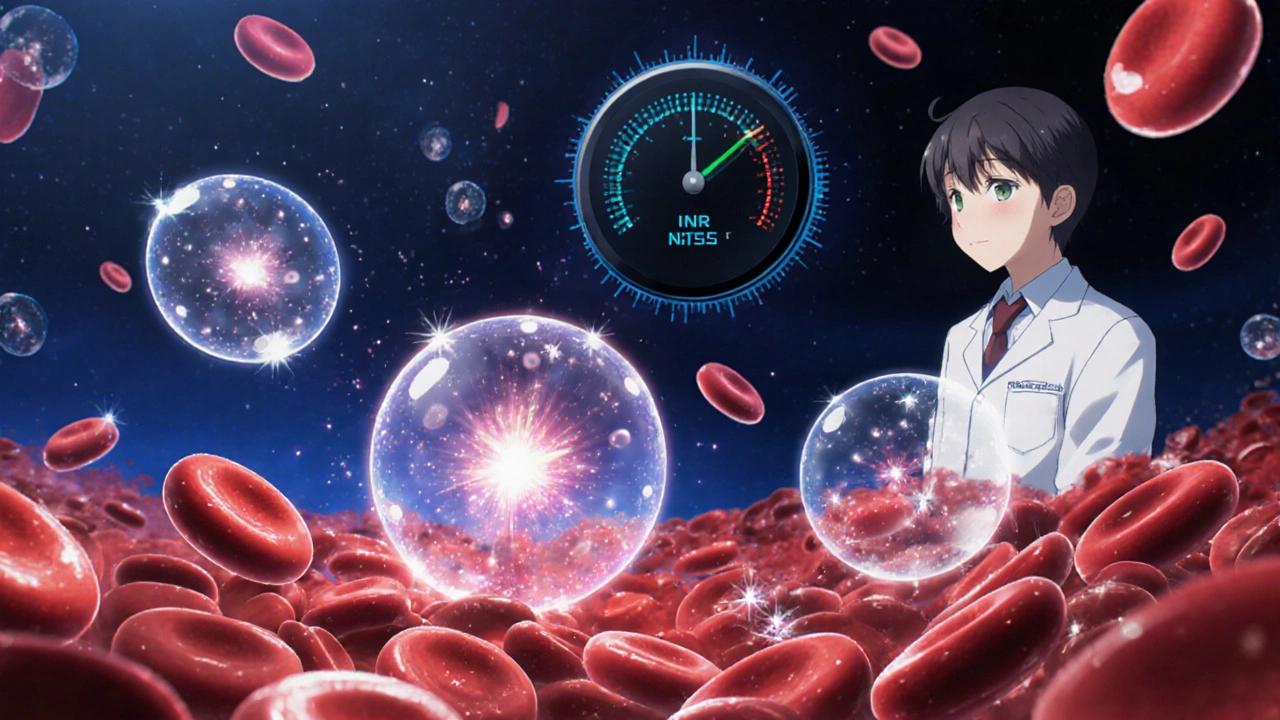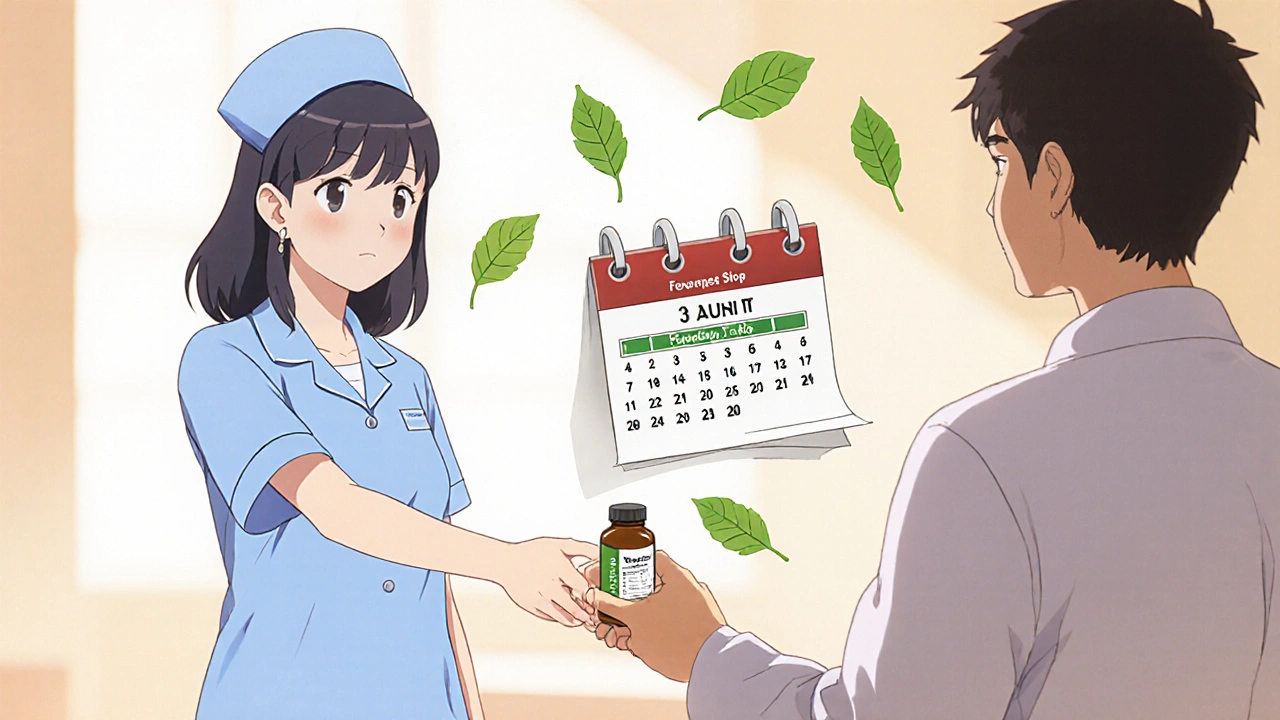Feverfew-Anticoagulant Bleeding Risk Calculator
Risk Assessment Tool
Feverfew (Tanacetum parthenium, a perennial herb traditionally used for migraines and inflammation) is gaining attention because its antiplatelet properties can tip the balance when patients are already on anticoagulants. If you or a client mixes these two, the chance of unexpected bruising, nosebleeds, or even serious bleeding can rise. This guide walks you through the science, the real‑world cases, and a step‑by‑step checklist to decide whether it’s safe to keep feverfew on the shelf.
Key Takeaways
- Feverfew’s active compound parthenolide blocks serotonin‑induced platelet aggregation, which can add to the effect of warfarin, apixaban, and other anticoagulants.
- Only one well‑documented case report links feverfew to a true coagulopathy, but dozens of user‑reported bruising events suggest a modest risk.
- Baseline PT/INR and PTT testing before starting feverfew, then re‑checking every two weeks for the first month, catches most problems early.
- Discontinue feverfew 14 days before any surgery; a 2-3 week taper reduces withdrawal symptoms and stabilises clotting numbers.
- When choosing a migraine supplement for an anticoagulated patient, consider low‑risk alternatives such as magnesium or riboflavin.
Understanding Feverfew
Feverfew belongs to the Asteraceae family, the same group that includes daisies and ragweed. The herb’s therapeutic reputation dates back to ancient Greece, but modern research focuses on parthenolide, which makes up 0.1-1 % of dried leaf material. Standardized supplements contain 0.2-0.7 % parthenolide and are usually taken in 50-300 mg daily doses for migraine prevention.
Besides migraine relief, feverfew shows anti‑inflammatory and antiplatelet actions. The antiplatelet effect is highly selective: it blocks platelet aggregation triggered by serotonin but leaves ADP‑ and thrombin‑mediated pathways largely untouched. That selectivity is why the herb is often classified as a “moderate” bleeding‑risk herb in the ‘Few Gs’ mnemonic (feverfew, ginger, ginkgo biloba, garlic, ginseng).
How Feverfew Affects Blood Clotting
Platelets stick together when serotonin binds to its receptor on the platelet surface. Parthenolide competes with serotonin, reducing the clump‑forming signal. In vitro studies show a 30-45 % drop in serotonin‑induced aggregation at clinically relevant parthenolide concentrations.
For patients already on anticoagulants that target the clotting cascade (e.g., warfarin, apixaban, rivaroxaban), the added platelet inhibition can shift the haemostatic balance toward bleeding. The effect is not dramatic-most lab values stay within normal ranges-but in vulnerable individuals (elderly, renal impairment, or those taking multiple antiplatelet agents) even a small shift matters.
Feverfew also blocks several cytochrome P450 enzymes (CYP1A2, 2C8, 2C9, 2C19, 2D6, 3A4). Warfarin is metabolized mainly by CYP2C9 and CYP3A4, so feverfew could raise warfarin plasma levels by roughly 18‑22 % in vitro. Clinical relevance is still debated because human trials are scarce.
Anticoagulants Overview
Anticoagulants fall into two camps: vitamin K antagonists (warfarin) and direct oral anticoagulants (DOACs) such as apixaban, rivaroxaban, and dabigatran. Their primary goal is to interfere with clotting factors, not platelets. Because they act upstream of platelet aggregation, combining them with a platelet‑inhibiting herb like feverfew creates a double‑hit scenario.
Monitoring differs: warfarin requires regular PT/INR checks, while DOACs usually do not need routine lab monitoring. However, when a patient adds feverfew, clinicians should consider a baseline PT/INR (or PTT for dabigatran) and repeat testing after two weeks to catch any unexpected rise.

Interaction Mechanisms
- Pharmacodynamic synergy: Feverfew’s antiplatelet action adds to the anticoagulant’s clot‑blocking effect, increasing overall bleeding propensity.
- Pharmacokinetic interference: Inhibition of CYP3A4 and CYP2C9 may slow warfarin clearance, leading to higher INR.
- Serotonin pathway overlap: Some DOACs (e.g., apixaban) also affect platelet function indirectly, compounding the serotonin‑blockade from parthenolide.
Because the evidence is mostly theoretical, the safest approach is to treat the combination as “high‑alert” until more data appear.
Clinical Evidence & Case Reports
The strongest human evidence comes from a 2021 NIH case report. A 36‑year‑old woman on an unnamed dose of feverfew developed prolonged PT (27.3 s) and PTT (42 s) with a hemoglobin drop to 10 g/dL. After stopping feverfew for four months, her labs normalized (PT 14.4 s, PTT 29 s, Hb 12 g/dL). No other medications explained the change.
Beyond that, user‑generated data on Reddit, Healthline, and survey platforms show a pattern: 11-14 % of feverfew users on low‑dose aspirin report easy bruising, and about 7 % experience nosebleeds lasting longer than usual. While anecdotal, the consistency across platforms nudges clinicians to be cautious.
Compared with other ‘Few Gs’ herbs, feverfew sits in the middle. Ginkgo biloba has >12 FDA‑reported warfarin interactions with marked INR spikes. Garlic and ginger tend to clear within 72 hours, whereas feverfew’s half‑life is roughly 7‑10 days, making pre‑operative tapering more critical.
Practical Risk Assessment for Clinicians
Use this quick checklist whenever a patient on an anticoagulant mentions feverfew:
- Confirm the formulation (capsule, liquid, fresh leaf) and dose of feverfew.
- Obtain baseline coagulation tests: PT/INR for warfarin, PTT for dabigatran, or a complete blood count.
- Ask about other antiplatelet agents (aspirin, clopidogrel) or “bleeding herbs” (ginkgo, garlic).
- If the patient is stable and bleeding risk is low, consider a modest dose (<100 mg daily) and schedule repeat PT/INR in 14 days.
- For high‑risk situations (recent bleed, surgery, renal impairment), advise tapering feverfew over 2-3 weeks and stopping 14 days before the procedure.
- Document the decision and educate the patient on signs of bleeding: new bruises, prolonged nosebleeds, dark stools, or unexplained fatigue.
When in doubt, pause feverfew and reassess. The cost of a missed bleed far outweighs the modest migraine benefit for most patients.

Patient Management Guidelines
Patients often ask how to keep their migraine relief without jeopardising blood thinners. Here’s a patient‑friendly plan:
- Start low, go slow: Begin with 50 mg of standardized feverfew once daily.
- Monitor: Keep a bleeding diary for the first month; note any new bruises or prolonged nosebleeds.
- Lab check: If you’re on warfarin, have your INR checked within two weeks of starting feverfew.
- Plan surgery: Stop feverfew at least 14 days before any operation. A gradual taper (e.g., reduce dose by 25 % every 5 days) eases withdrawal symptoms like insomnia or joint pain.
- Switch if needed: Magnesium, riboflavin, or butterbur have lower bleeding potential and may be safer alternatives.
Encourage open communication with the prescribing doctor; many clinicians are unaware that patients self‑prescribe feverfew for migraines.
Comparison with Other ‘Few Gs’ Herbs
| Herb | Primary Mechanism | Evidence of Interaction with Anticoagulants | Recommended Pre‑Surgery Stop Time |
|---|---|---|---|
| Feverfew | Serotonin‑platelet inhibition (parthenolide) | 1 documented coagulopathy case; multiple anecdotal bruising reports | 14 days (2‑3 week taper) |
| Ginkgo biloba | Broad platelet inhibition + increased fibrinolysis | 12 FDA‑reported warfarin‑INR spikes | 7 days |
| Garlic | Inhibition of platelet aggregation via allicin | Limited case reports; modest INR changes | 7 days |
| Ginseng | Variable; can both inhibit and stimulate platelet function | Inconsistent data; occasional INR elevation | 7 days |
| Ginger | Inhibits thromboxane synthesis | Few reports; generally low risk | 7 days |
Notice how feverfew’s longer taper reflects its slower clearance and the potential for withdrawal symptoms that other herbs rarely cause.
Frequently Asked Questions
Can I take feverfew with apixaban?
Apixaban is a factor Xa inhibitor, so it works on the clotting cascade, not platelets. Feverfew’s platelet‑blocking effect can still add to bleeding risk. The safest route is to avoid the combination or, if you must use both, have a clinician check a baseline PT/INR and repeat it after two weeks.
How long before surgery should I stop feverfew?
Professional societies recommend stopping feverfew at least 14 days before any operation. Because the herb clears slowly, a 2-3 week taper (e.g., 100 mg → 75 mg → 50 mg → 0 mg) reduces the chance of rebound headache and withdrawal symptoms.
What lab tests should I watch while on feverfew and warfarin?
Track PT/INR every two weeks for the first month after adding feverfew. If the INR climbs more than 0.5 units above your therapeutic range, reduce the warfarin dose or pause the herb.
Are liquid feverfew extracts riskier than capsules?
Extracts usually deliver a higher concentration of parthenolide per milligram, so they can produce a stronger antiplatelet effect. Capsules that are standardized to 0.2‑0.7 % parthenolide are generally safer, but the same precautions apply.
What are the common withdrawal symptoms after stopping feverfew?
People report insomnia (≈32 %), joint pain (27 %), nervousness (24 %) and a rebound headache (≈41 %) for 3‑14 days after stopping, especially after long‑term use (>6 months).
Bottom line: the feverfew anticoagulant interaction isn’t a daily headline, but it’s real enough to merit a cautious approach. By checking labs, timing the stop‑date before surgery, and choosing lower‑risk migraine alternatives when appropriate, you can keep both headache relief and bleeding safety in balance.


Gary Campbell
October 26, 2025 AT 17:17When you start mixing feverfew with a blood thinner, you’re stepping into a gray zone that the pharmaceutical lobby doesn’t want you to explore.
The herb contains parthenolide, a molecule that binds to the serotonin receptor on platelets and reduces their ability to clump together.
That sounds harmless until you remember that warfarin already dampens the clotting cascade by inhibiting vitamin K–dependent factors.
Add the two and you create a double‑hit scenario that can push the INR into a dangerous range without any obvious warning signs.
Laboratory studies have shown a 30‑45% drop in serotonin‑induced aggregation at the concentrations found in typical 100‑mg feverfew capsules.
Even more unsettling is feverfew’s inhibition of several cytochrome P450 enzymes, especially CYP2C9 and CYP3A4, which are the main pathways that clear warfarin.
In vitro data suggest an 18‑22% rise in warfarin plasma levels when feverfew is present, enough to turn a stable INR of 2.5 into something above 3.5.
The problem is that most clinicians don’t routinely check INR after a patient picks up an over‑the‑counter herb, assuming the supplement is benign.
What the industry doesn’t tell you is that the same enzyme inhibition can affect the metabolism of some DOACs, albeit to a lesser extent, and the data are still buried in grant‑funded research papers you never see.
If you’re already on a DOAC like apixaban, the pharmacodynamic synergy of platelet inhibition adds an extra bleed risk that standard coagulation tests won’t catch.
That’s why the ‘Few Gs’ mnemonic exists-to remind us that feverfew, ginger, ginkgo, garlic, and ginseng all deserve a caution flag.
The half‑life of parthenolide is roughly 7‑10 days, so even stopping the herb the day before surgery won’t clear it from your system in time.
A sensible protocol is to taper the supplement over two to three weeks and obtain a baseline PT/INR before re‑starting any anticoagulant.
Patients with renal impairment, advanced age, or concurrent aspirin therapy should be especially wary, as their bleeding threshold is already lowered.
Bottom line: the interaction is real, it’s under‑reported, and the safest route is to treat feverfew as a high‑alert ingredient unless you have a compelling reason to keep it.
Otherwise you’re gambling with a patchwork of anecdotal case reports and hidden industry data.
renee granados
November 2, 2025 AT 15:57Feverfew is a thin‑skinned excuse for pharma to hide the real bleeding danger.
Stephen Lenzovich
November 9, 2025 AT 14:37America's medical system prides itself on evidence, not folk‑medicine folklore that whispers about “natural” cures. Feverfew may sound harmless, but any supplement that meddles with platelet function should be vetted by our top research institutions. We can't afford to let unregulated herbs erode the hard‑won standards that keep our citizens safe.
asha aurell
November 16, 2025 AT 13:17The checklist is useful, but most patients ignore the two‑week lab repeat and suffer avoidable bruises.
Abbey Travis
November 20, 2025 AT 00:37I hear you, and that’s why I always walk patients through the timeline, setting calendar reminders for those follow‑up labs so they don’t slip through the cracks.
ahmed ali
November 26, 2025 AT 23:17Look, the whole feverfew‑warfarin drama is blown way out of proportion by people who cant read a simple study.
First off, the in‑vitro data you keep citing shows a modest enzyme inhibition, not a guaranteed bleed disaster.
Second, the case report you love to quote involved a patient who was also taking aspirin, ibuprofen, and a bunch of other herbs – that’s a cocktail, not a single herb effect.
Third, the half‑life of parthenolide is indeed a week or so, but the body clears it in a predictable fashion if you taper properly.
Fourth, most of the anecdotal bruising you see on forums is likely due to people forgetting to adjust their INR targets when they start any new supplement, not because feverfew is a secret poison.
Fifth, let’s not pretend that DOACs are immune; they have their own set of interactions, but the clinical significance is still debated.
Sixth, the “high‑alert” label sounds scarier than it is – it simply means you should monitor, not that you must avoid it forever.
Seventh, the real problem is the lack of clear guidance from clinicians, not the herb itself.
Eighth, you can safely use feverfew if you keep your INR within the therapeutic range and get tested after two weeks.
Ninth, the cost‑benefit for migraine relief often outweighs the tiny uptick in bleed risk for most healthy adults.
Tenth, remember that many patients find real relief from migraines with feverfew, improving their quality of life substantially.
Eleventh, you’re welcome to keep pushing fear‑mongering, but the data simply doesn’t back up a blanket prohibition.
Twelfth, if you really want to protect patients, focus on education about lab monitoring rather than outlawing a herb.
Deanna Williamson
November 30, 2025 AT 10:37Your points raise valid concerns about enzyme inhibition, yet the clinical data still show only modest INR shifts in the majority of patients, which suggests that vigilant monitoring can mitigate most risks.
Miracle Zona Ikhlas
December 7, 2025 AT 09:17Let’s keep sharing these practical tips; they empower patients to stay safe while still managing migraines.